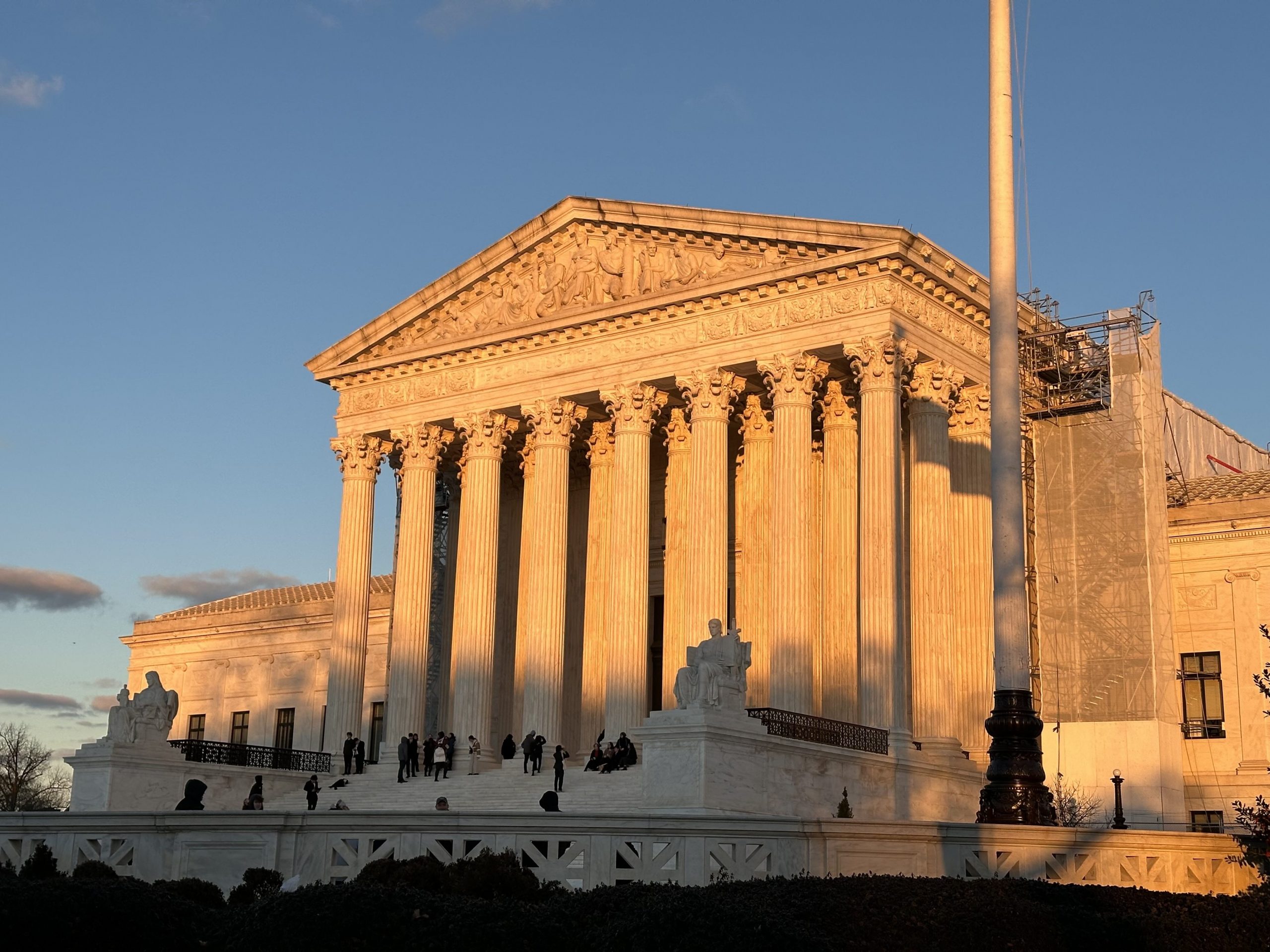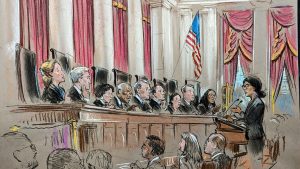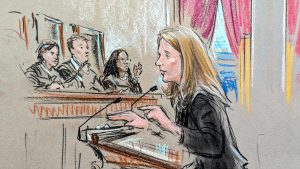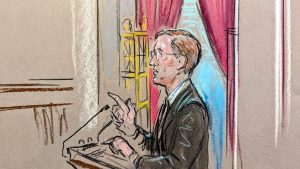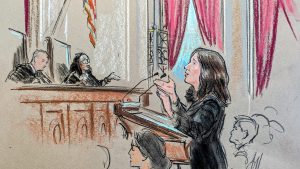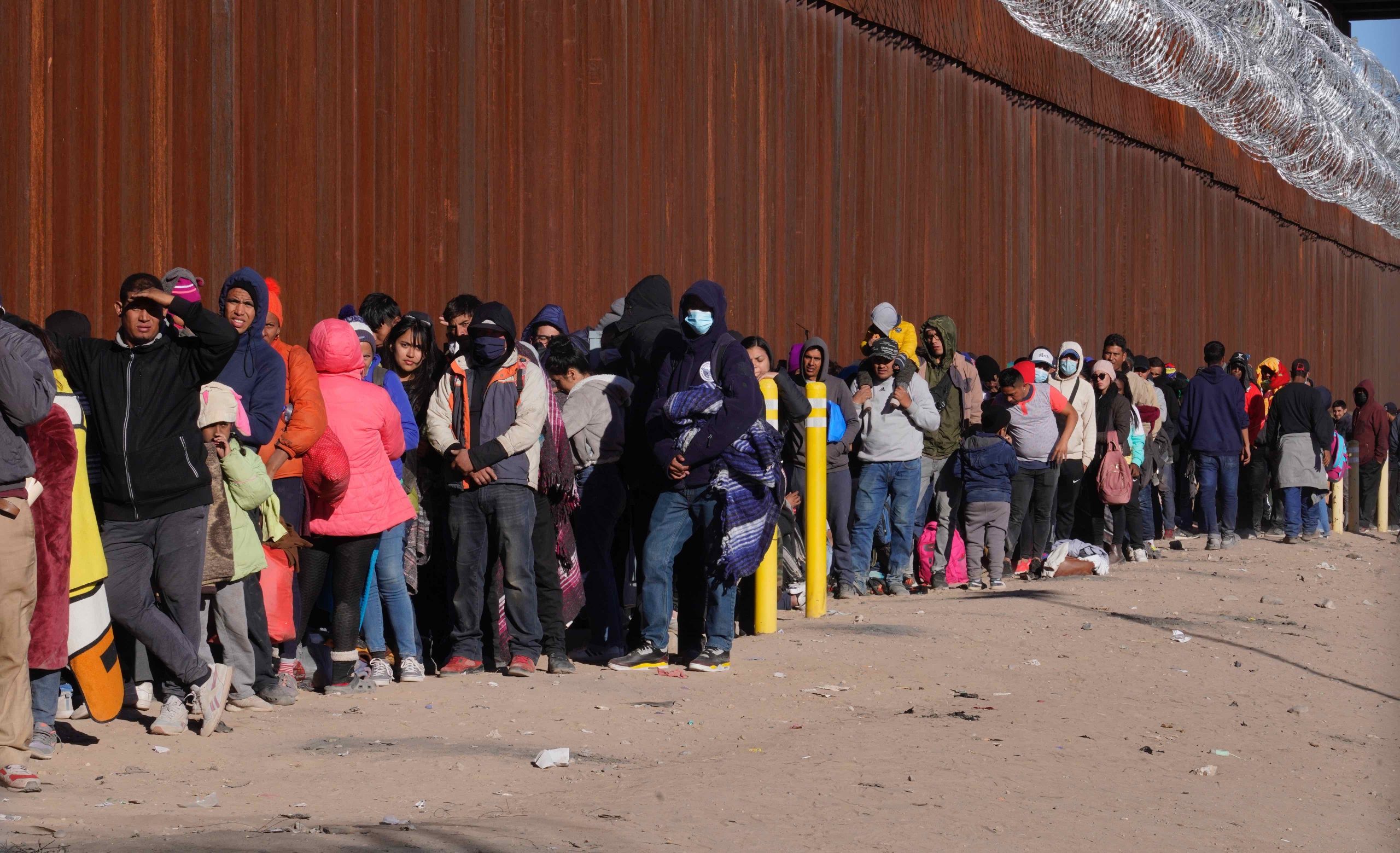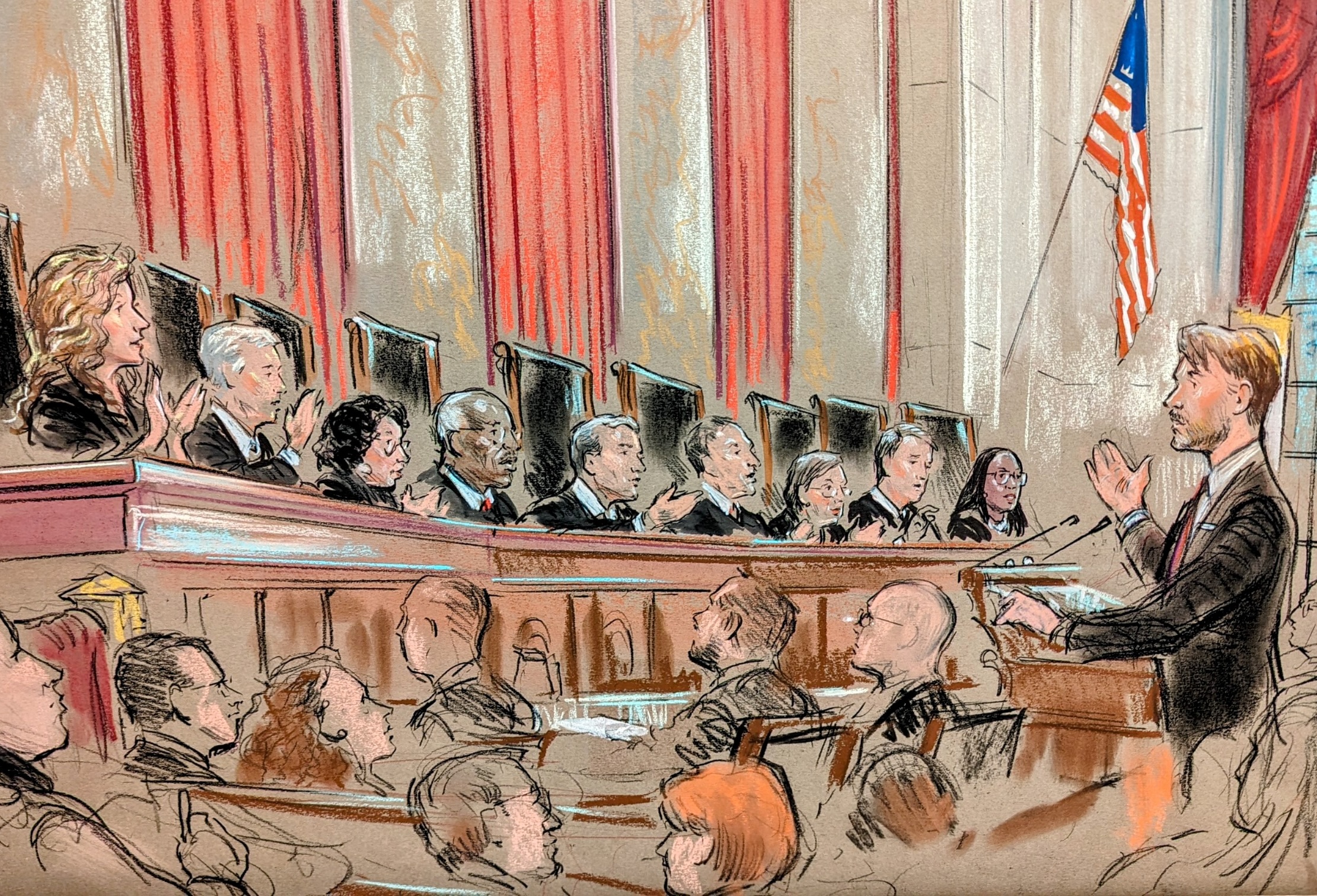Supreme Court likely to block EPA ozone regulation
ARGUMENT ANALYSIS
on Feb 21, 2024
at 3:50 pm
The four consolidated challenges to an EPA air pollution rule, fast-tracked off the justices’ emergency docket in December, headlined Wednesday’s arguments. (Katie Barlow)
The Supreme Court on Wednesday appeared sympathetic to a group of states, companies, and trade associations seeking to temporarily block a rule issued by the Environmental Protection Agency to reduce air pollution from power plants and other industrial facilities in 23 states that do not want to adjust their emissions policies. During approximately 90 minutes of oral arguments, the court’s conservative justices voiced skepticism about the process that the EPA followed in implementing the rule, while the court’s liberal justices questioned the wisdom of putting the rule on hold before any lower court has had a chance to weigh in.
The law at the center of the case is known as the “good neighbor” provision of the Clean Air Act. It requires “upwind” states to reduce emissions that affect the air quality in “downwind” states.
In 2015, the EPA issued new air-quality standards for ozone pollution, which at high levels can cause major health problems. The new EPA standards triggered an obligation for states to submit plans to indicate both how they would comply with those standards and, in particular, how they would reduce emissions that affect the air quality in downwind states.
The dispute at the center of this case arises from the EPA’s decision last year to reject the plans submitted by 21 states, which had not proposed any changes to their emissions plans. One month after throwing out the state plans, the EPA published its own plan for those states, as well as for two other states that had not submitted plans.
Before the EPA’s plan could go into effect last August, three states — Ohio, Indiana, and Virginia, went to the U.S. Court of Appeals for the District of Columbia Circuit to challenge it, as did several companies and trade associations also affected by the plan.
When a divided D.C. Circuit denied the challengers’ request to block the plan while litigation continued, the challengers came to the Supreme Court with an emergency appeal, on what is sometimes called the court’s “shadow docket.” In December, the justices fast-tracked the case for oral argument on Wednesday.
Ohio Solicitor General Mathura Sridharan argues for the state. (William Hennessy)
Representing the states, Ohio Solicitor General Mathura Sridharan argued that the process by which the EPA had arrived at its federal plan was flawed. Specifically, she contended, 12 states had gone to court to challenge the EPA’s rejection of their plans, and several courts of appeals have put those rejections on hold, precluding the EPA from imposing its federal plan on those states.
But the EPA’s plan, Sridharan explained, relied on the assumption that all 23 states would participate in the federal plan. Once it became clear that not all states would be part of the plan, she told the justices, the EPA need to consider what the effect of less-than-full participation would have.
The EPA’s failure to do so, Sridharan continued, “has become consequential,” because the EPA’s plan “now regulates under half of the states and a quarter of the emissions that the EPA originally set out to regulate.”
Catherine Stetson, representing companies that own and operate natural gas pipeline engines, emphasized that “the purpose of the ‘good neighbor’ provision is to reduce the significant contribution that upwind states make to downwind states” – not simply to protect downwind states. Therefore, she reasoned, the EPA should have examined whether, with only 11 states subject to the federal plan, “there would still be a significant contribution” to downwind air quality.
Catherine Stetson argues for the pipeline engine companies. (William Hennessy)
Stetson added that, if the rule is allowed to remain in effect, it could mean “hundreds of millions if not billions of dollars in costs over the next 12 to 18 months.” By contrast, she suggested, there is not a “very, very significant downwind problem” but instead a “minuscule” one.
Deputy U.S. Solicitor General Malcolm Stewart, representing the EPA, pushed back against any suggestion that the EPA had failed to consider what might happen if some states were not ultimately subject to the federal plan. Instead, he insisted, “EPA anticipated from the outset that the plan was one whose geographic composition could change,” and the agency “devised the requirements for each state in order that they would be workable if a smaller or a larger set of states were ultimately covered.”
Deputy U.S. Solicitor General Malcolm Stewart argues for the EPA. (William Hennessy)
Moreover, Stewart added, even if the federal plan only currently applies to 11 states, rather than 23, “the requirements that are imposed on sources are exactly the same as would have been imposed on sources in those 11 states if the full plan had been implemented,” and the 11 states are still providing the benefits of reduced air pollution.
But the court’s conservative justices were unpersuaded by Stewart’s characterization of the process that EPA used. Justice Brett Kavanaugh was the most openly sympathetic to the challengers. He repeatedly observed that the EPA had been told that the rejections of the state plans would be “problematic” and “would unravel the whole” federal plan. But the EPA merely indicated, Kavanaugh emphasized, that even if the plan did not apply to some states, it could still be implemented for the remaining states, without providing the kind of explanation about how the revised plan would work that the federal laws governing administrative agencies require.
Justice Neil Gorsuch echoed Kavanaugh’s concerns. He told Stewart that the EPA had “originally proposed a 23-state solution” but then received comments warning that not all 23 states would necessarily be subject to the plan. The EPA responded, he noted, by indicating that the plan would still remain in force even if some states were exempted from it. But “nobody got an opportunity to comment on that,” said Gorsuch, as federal law might require.
Chief Justice John Roberts pressed Stewart to say when, if the plan were allowed to remain in effect, the EPA would address the effect of the change in the number of states covered by the plan.
Stewart indicated that the EPA did not necessarily “have any plan to do that,” both because the agency had already analyzed the broader picture and because of the prospect that the EPA could ultimately prevail in some of the challenges to its rejections of state plans. For example, he said, last week the U.S. Court of Appeals for the 10th Circuit transferred challenges by Utah and Oklahoma to the D.C. Circuit, which “could result in Utah and Oklahoma being put back into the federal plan.”
But Roberts appeared unsatisfied by that response, suggesting to Stewart that the sharp reduction in the volume of emissions covered by the federal plan was “something new” that the EPA should consider. “And in terms of why it’s necessary to look at this here,” Roberts continued, “if you think it’s an important question, it’s because EPA will not look at it until after the hundreds of millions of dollars of costs are incurred.”
New York Deputy Solicitor General Judith Vale representing the state. (William Hennessy)
Justice Elena Kagan suggested that the challengers were imposing too high a bar on the EPA. Once it became aware of the prospect that some states might be exempt from the federal plan, she asked Sridharan, was the agency required to consider every possible combination of the 23 states. There are, she observed, “like four million different permutations. What was the EPA supposed to do?”
But the liberal justices’ primary target was instead what they characterized as the unusual procedural posture in which the dispute came to the court. If the court were to put the EPA’s federal plan on hold in these cases, they repeatedly contended, it would effectively open the door for the court to become a forum of first resort whenever someone wants to challenge a federal rule.
Justice Ketanji Brown Jackson told Sridharan that it was, in her view, “fairly extraordinary … to be asking the Court to decide this matter when you haven’t even” briefed, much less lost, the case in the D.C. Circuit yet. Pointing to the compliance deadline of 2026 she said, “So I’m trying to understand what the emergency is that warrants Supreme Court intervention at this point.” And she suggested that, in cases like this, the Supreme Court should require applicants like the challengers to show “extraordinary harm” before putting a federal rule on hold.
Jackson made her point even more clearly a few minutes later, telling Sridharan that “what I’m a little concerned about is that really your argument is just boiling down to we think we have a meritorious claim and we don’t want to have to follow the law while we’re challenging it. And I don’t understand why every single person who is challenging a rule doesn’t have the same set of circumstances.”
Justice Sonia Sotomayor also voiced objections to the process by which the dispute was before the court. She suggested that it was an “inversion of normal rules” for the challengers to try to “bypass the very court who’s going to make the substantive decision,” particularly when the states had not asked the D.C. Circuit to fast-track the proceedings.
Kagan expressed similar concerns. In response to Sridharan’s insistence that a key issue in the case is “the EPA failed to consider in the first instance what happens when there is lesser participation” in the federal plan, Kagan reiterated that some states could eventually lose their challenges to the EPA’s rejection of the state plans. And if that’s the case, she continued, “the idea that you can be here and demanding emergency relief just because states have kicked up a lot of dust seems not the right answer to me.” But the rest of the court did not seem to share the liberal justices’ misgivings, a promising sign for the challengers.
A decision is expected by summer.
This article was originally published at Howe on the Court.

